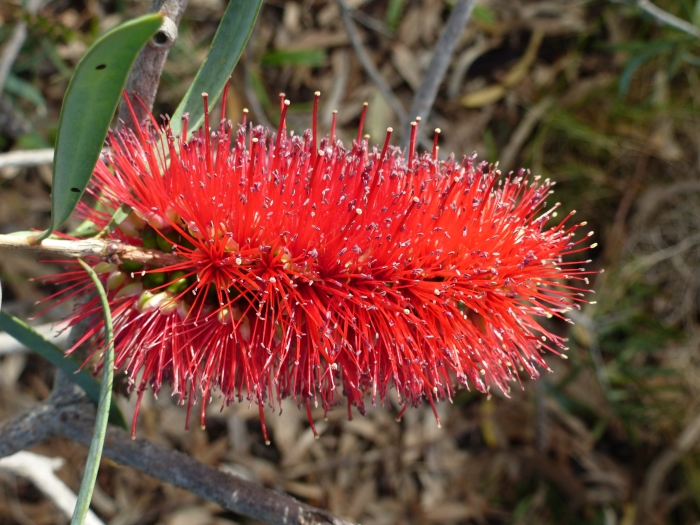Lesser Bottlebrush
(Callistemon phoeniceus)
Lesser Bottlebrush (Callistemon phoeniceus)
/
/

Geoff Derrin
CC BY-SA 4.0
Image By:
Geoff Derrin
Recorded By:
Copyright:
CC BY-SA 4.0
Copyright Notice:
Photo by: Geoff Derrin | License Type: CC BY-SA 4.0 | License URL: https://creativecommons.org/licenses/by-sa/4.0 | Uploader: Gderrin | Publisher: Wikimedia Commons | Title: Melaleuca_phoenicea_(flowers,_Kings_Park).jpg | Notes: |





















Estimated Native Range
Summary
Callistemon phoeniceus, commonly known as Lesser Bottlebrush, is an evergreen shrub native to the Mediterranean-type climate regions of Western Australia, particularly thriving in plains and open woodlands. It typically grows to a height of 6 meters (20 feet) and is characterized by its thick, blue-green leaves and distinctive spikes of scarlet bottlebrush flowers that bloom in spring and summer, attracting pollinators such as birds and bees. The flowers are quite showy, making it a popular ornamental plant.
Lesser Bottlebrush is valued for its vibrant red flowers and its resilience in various conditions, making it suitable for urban planting, borders, and as a specimen plant in gardens. It is adaptable to a range of soil types but prefers well-drained soils and full sun exposure to flourish. While it can tolerate low water conditions, moderate watering is recommended to maintain its health and vigor. Regular light pruning and fertilization can encourage denser growth and more prolific flowering. It is generally low-maintenance but can be susceptible to scale insects and sooty mold. Gardeners should be aware that in some regions, Callistemon species can become invasive, so it is important to monitor and manage growth accordingly.CC BY-SA 4.0
Lesser Bottlebrush is valued for its vibrant red flowers and its resilience in various conditions, making it suitable for urban planting, borders, and as a specimen plant in gardens. It is adaptable to a range of soil types but prefers well-drained soils and full sun exposure to flourish. While it can tolerate low water conditions, moderate watering is recommended to maintain its health and vigor. Regular light pruning and fertilization can encourage denser growth and more prolific flowering. It is generally low-maintenance but can be susceptible to scale insects and sooty mold. Gardeners should be aware that in some regions, Callistemon species can become invasive, so it is important to monitor and manage growth accordingly.CC BY-SA 4.0
Plant Description
- Plant Type: Shrub
- Height: 1.5-9 feet
- Width: 6-9 feet
- Growth Rate: Moderate
- Flower Color: Red
- Flowering Season: Spring, Summer
- Leaf Retention: Evergreen
Growth Requirements
- Sun: Full Sun
- Water: Low, Medium
- Drainage: Medium
Common Uses
Bee Garden, Bird Garden, Butterfly Garden, Drought Tolerant, Hedges, Hummingbird Garden, Low Maintenance, Showy Flowers, Street Planting
Natural Habitat
Mediterranean-type climate regions and open woodlands
Other Names
Common Names: Scarlet Bottlebrush, Bottlebrush
Scientific Names: , Callistemon phoeniceus, Melaleuca phoenicea,
GBIF Accepted Name: Callistemon phoeniceus Lindl.